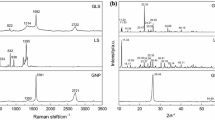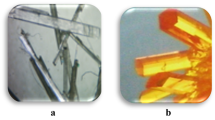Abstract
A novel ε-HNIW-based explosive formula with low sensitive and high energy was developed by systematically researching the processes of recrystallization, granularity gradation, and coating of ε-HNIW and option of energetic deterrents. The grain size and morphology of HNIW crystals were modified by solvent/antisolvent recrystallization. The ε-HNIW particles were graded and coated by emulsion polymerization method with 551 glue. The binder reduced the mechanical sensitivity of ε-HNIW significantly and showed good compatibility with ε-HNIW, but also weakened the decomposition enthalpy. With the purpose of developing new energetic deterrents in insensitive high explosive formulations, novel carbon materials graphene oxide (GO) and reduced graphene oxide (rGO) were prepared and incorporated in plastic-bonded explosive (PBX) formulations. For comparison, the effects of conventional deterrent flake graphite were also involved. It turned out that the mechanical sensitivities of ε-HNIW/551 glue have all reduced to some extent with the incorporation of graphite, GO, and rGO. Flake graphite induced the PBX decompose earlier slightly and weaken the heat output. The addition of GO resulted in noticeable antedating decomposition of ε-HNIW/551 glue although remarkably increased the decomposition heat. The formula of ε-HNIW/551 glue/rGO provided a moderate growth in decomposition heat and best thermal stability. In slow cook-off tests, the formulas of ε-HNIW/551 glue and ε-HNIW/551 glue/rGO showed good thermal stability and might be qualified to apply safely under 200 °C. Comprehensively considering the mechanical sensitivity, thermals stability, energy performance, and practical application, ε-HNIW/551 glue/rGO is supposed to be an eligible insensitive high-energy PBX formula.













Similar content being viewed by others
References
Gibbs TR, Popolato A, editors. LASL Explosive Property Data. Berkeley, CA: University of California Press; 1980.
Dong HS, Zhou FF. High energy explosives and correlative physical properties. Beijing: Science Press; 1984.
Jaw KS, Lee JS. Thermal behaviors of PETN base polymer bonded explosives. J Therm Anal Calorim. 2009;93(3):953–7.
Bouma RHB, Duvalois W, et al. Characterization of a commercial grade CL-20: morphology, crystal shape, sensitivity and shock initiation testing by flyer impact. In: Proceedings of the 31st Int. Annual Conference of ICT, Karlsruhe, Germany; 2000: 105, p. 1.
Nielsen AT. Synthesis of polynitropolyaza caged nitramines chemical propulsion information agency; 1987, Publication no.473.
Ordzhonikidze O, Pivkina A, Frolov Y, et al. Comparative study of HMX and CL-20. J Therm Anal Calorim. 2011;105:529–34.
Geetha M, Nair UR, Sarwade DB, et al. Studies on CL-20: the most powerful high energy material. J Therm Anal Calorim. 2003;73:913–22.
Yu L, Jiang X, Guo X, et al. Effects of binders and graphite on the sensitivity of ε-HNIW. J Therm Anal Calorim. 2013;112(3):1343–9.
Foltz MF. Thermal stability of ε-hexanitrohexaazaisowurtzitane in an estane formulation. Propell Expl Pyrotech. 1994;19(2):63–9.
Tarver CM, Simpson RL, Urtiew PA. Shock initiation of an (epsilon)-CL-20-estane formulation. In: Proceedings of the American Physical Society biennial conference on shock compression of condensed matter. Seattle, WA (United States); 1995.
Pant CS, Wagh RM, Nair JK, et al. Dendtritic azido ester: a potential energetic additive for high energy material (HEM) formulations. J Energ Mater. 2006;24(4):333–9.
Geim AK, Novoselov KS. The rise of graphene. Nat Mater. 2007;6(3):183–91.
Stankovich S, Dikin DA, Piner RD, et al. Synthesis of graphene-based nanosheets via chemical reduction of exfoliated graphite oxide. Carbon. 2007;45(7):1558–65.
Dikin DA, Stankovich S, Zimney EJ, et al. Preparation and characterization of graphene oxide paper. Nature. 2007;448(7152):457–60.
Compton OC, Nguyen SBT. Graphene oxide, highly reduced graphene oxide, and graphene: versatile building blocks for carbon-based materials. Small. 2010;6(6):711–23.
Krishnan D, Kim F, Luo J, et al. Energetic graphene oxide: challenges and opportunities. Nano Today. 2012;7(2):137–52.
Chen H, Chen S, Li L, et al. Quantitative determination of ε-phase in polymorphic HNIW using X-ray diffraction patterns. Propell Expl Pyrotech. 2008;33(6):467–71.
Sivabalan R, Gore GM, Nair UR, et al. Study on ultrasound assisted precipitation of CL-20 and its effect on morphology and sensitivity. J Hazard Mater. 2007;139(2):199–203.
Kamlet MJ, Jacobs SJ. Chemistry of detonations. I. a simple method for calculating detonation properties of C [Single Bond] H [Single Bond] N [Single Bond] O Explosives. J Chem Phys. 1968;48:23.
Huang H. Particle grade technique and application on energetic materials (in Chinese). Chin J Energ Mater. 2001;9(4):161–4.
Hummers WS Jr, Offeman RE. Preparation of graphitic oxide. J Am Chem Soc. 1958;80(6):1339.
Mkhoyan KA, Contryman AW, Silcox J, et al. Atomic and electronic structure of graphene-oxide. Nano Lett. 2009;9(3):1058–63.
Gómez-Navarro C, Meyer JC, Sundaram RS, et al. Atomic structure of reduced graphene oxide. Nano Lett. 2010;10(4):1144–8.
Hernandez Y, Nicolosi V, Lotya M, Blighe FM, Sun ZY, De S, et al. High-yield production of graphene by liquid-phase exfoliation of graphite. Nat Nanotechnol. 2008;3(9):563–8.
Yang D, Velamakanni A, Bozoklu G, et al. Chemical analysis of graphene oxide films after heat and chemical treatments by X-ray photoelectron and micro-Raman spectroscopy. Carbon. 2009;47(1):145–52.
Zhang CY. Computational investigation on the desensitizing mechanism of graphite in explosives versus mechanical stimuli: compression and slide. Phys Chem B. 2007;111:6208–13.
Lee JS, Jaw KS. Thermal decomposition properties and compatibility of CL-20, NTO with silicone rubber. J Therm Anal Calorim. 2006;85(2):463–7.
Kim F, Luo J, Cruz-Silva R, et al. Self-propagating domino-like reactions in oxidized graphite. Adv Funct Mater. 2010;20(17):2867–73.
Nika DL, Ghosh S, Pokatilov EP, et al. Lattice thermal conductivity of graphene flakes: comparison with bulk graphite. Appl Phys Lett. 2009;94(20):203103-1–3.
Balandin AA. Thermal properties of graphene and nanostructured carbon materials. Nat Mater. 2011;10(8):569–81.
Dickson PM, Asay BW, Henson BF. Thermal cook–off response of confined PBX 9501. P Roy Soc Lond A Mat. 2004;460(2052):3447–55.
Acknowledgements
The authors express heartful thanks to Shanxi North Guanlv Chemical Co., Ltd for providing us experimental facility in the “Insensitive Coating” section. We would also like to thank Jia Hongxuan and Liu Bo of this company for providing technical assistance.
Author information
Authors and Affiliations
Corresponding authors
Rights and permissions
About this article
Cite this article
Yu, L., Ren, H., Guo, Xy. et al. A novel ε-HNIW-based insensitive high explosive incorporated with reduced graphene oxide. J Therm Anal Calorim 117, 1187–1199 (2014). https://doi.org/10.1007/s10973-014-3928-7
Received:
Accepted:
Published:
Issue Date:
DOI: https://doi.org/10.1007/s10973-014-3928-7




